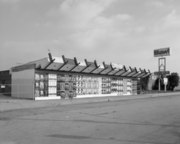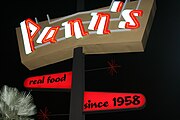Helen Liu Fong
Helen Liu Fong | |
|---|---|
Los Angeles, California, U.S. | |
| Died | 17 April 2005 (aged 78) |
| Occupation(s) | Architect, Interior Designer |
Helen Liu Fong (January 14, 1927–April 17, 2005) was an American architect and interior designer from Los Angeles, California. Fong was an important figure in the Googie architecture movement, designing futuristic buildings like Norms Restaurant, the Holiday Bowl, Denny's, Bob's Big Boy, and Pann's Coffee Shop that helped usher in an era of boomerang angles, dynamic forms and neon lights.[1][2][3] Fong became one of the first women to join the American Institute of Architects, and worked with Armet and Davis on many of her most well-known projects.[4] Many of Fong's best-known building designs feature large glass fronts and bold colors on interior walls, designed to stand out and entice potential customers.[5]
Background and education
Fong was born in Chinatown, Los Angeles to Chinese immigrant parents, one of five children. Fong grew up working in her family's laundry business, and knew by age 12 that she wanted to become an architect.[6] She began attending University of California, Los Angeles in 1943, transferring to University of California, Berkeley after two years. Fong graduated with a degree in city planning from the University of California, Berkeley in 1949.[1]
Career
Fong joined the architecture firm of
The mid 1950s saw Fong working on two of her firm's most well-known designs, Norms Restaurant and the Holiday Bowl.[6] The Norms designed by Armet and Davis in 1955 was not their first location, but the building's iconic pennant-based sign and semi-open kitchen design became hallmarks of the company's image.[6] Fong's interior design aimed to make the restaurant more efficient for guests and employees, as well as creating spectacle that would lure in new customers.[6]
The Holiday Bowl, built in 1958 in the Crenshaw neighborhood, became one of Fong's most celebrated projects.[6] She led the design of the cocktail lounge, putting in touches like a 3-D map of Japan, to pay tribute to the Japanese American community, just rebuilding after World War II internment.[6] The Holiday Bowl stood as a landmark and community center in Crenshaw for over four decades, bringing together Japanese Americans, African Americans, and Chinese Americans, among others.[6]
Fong's work was rewarded with a promotion to associate at Armet & Davis in 1964, charging her with handling client relationships and managing projects in addition to her design work.[6] Fong retired from the design firm in the late 1970s.[1]
Legacy
In 2012, the
See also
- History of the Chinese Americans in Los Angeles
- List of California women architects
References
- ^ a b c Woo, Elaine (26 April 2005). "Obituaries; Helen Liu Fong, 78; Architect Created Futuristic Designs for Coffee Shops". Los Angeles Times. Retrieved 21 February 2015.
- ^ Hirshowitz, Larry (December 2000). "Almost Famous". LA Magazine. LA Magazine.
- ^ Cramer, James P (2006). "Obituaries". Almanac of Architecture and Design. Greenway Communications.
- ^ Chung, Sue Fawn. "Pioneering Chinese American Architects". National Trust for Historic Preservation. National Trust for Historic Preservation. Retrieved 21 February 2015.
- ^ Favre, Jeff (27 January 2012). "How Four Chinese American Architects Helped Shape Los Angeles". Ventura County Star. Retrieved 21 February 2015.
- ^ a b c d e f g h i j k Breaking Ground: Chinese American Architects in Los Angeles (1945-1980). Chinese American Museum, Los Angeles. January 2012. pp. 37–46.
- ^ Michelson, Alan. "Fong, Helen". Pacific Coast Architecture Database (PCAD). University of Washington. Retrieved 21 February 2015.
- ^ "Breaking Ground: Chinese American Architects in Los Angeles (1945-1980)". Pacific Standard Time. Retrieved 31 August 2020.
External links
- Meares, Hadley (May 30, 2019). "The designer who gave Googie its flair". Curbed Los Angeles.
- Beverly Willis Architecture Foundation, Episode 3: Fast Food and Radical Rooflines: Helen Fong Shapes Los Angeles Coffee Shops



